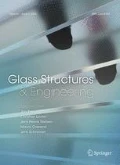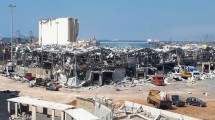Abstract
Revolving entrance doors—usually built as some kind of all glass structure—are part of many publicly accessible buildings. As the architectural demands rise regarding transparency and slenderness of façade members, the entrance doors have to and do go along with these demands. But even if the façade is designed carefully and verified according all relevant standards, the revolving doors are usually considered as a machine, coming with some certificate. This point of view is mostly shared by the manufacturer and the basis for the call for proposals. The certificates provided by the door manufacturer considers the electrical safety, the safety aspects for people handling and using the doors regarding the risk of persons being jammed or hit by the turning door leaves, but not the structural safety of the door system in means of resistance to live, dead, wind or earthquake loads. If we look at the design and verification effort made for standard façade elements, even windows on the one hand, and the different failure consequences for windows and revolving doors on the other hand, it becomes obvious that especially to non-standard and large-scale doors should be paid some attention regarding its structural safety. Below the legal situation of revolving doors is considered in the European context and two quite different examples of revolving doors are discussed regarding their structural assessment.














Similar content being viewed by others
References
ASTM E 1300: Standard practice for determining load resistance of glass in buildings (2016)
DIN 18650-1: Powered pedestrian doors—part 1: product requirements and test methods (2010-06)
DIN 18650-2: Powered pedestrian doors—part 2: safety at powered pedestrian doors (2010-06)
EN 13830: Curtain walling—product standard (2015-07)
EN 14351-1: Windows and doors—product standard, performance characteristics—part 1: windows and external pedestrian doorsets (2016-12)
EN 16005: Power operated pedestrian doorsets— safety in use—requirements and test methods (2013-01)
ETAG 002-1: Guideline for European technical approval of structural sealant glazing kits (SSGK)—part 1: supported and unsupported systems
Author information
Authors and Affiliations
Corresponding author
Additional information
Publisher's Note
Springer Nature remains neutral with regard to jurisdictional claims in published maps and institutional affiliations.
Rights and permissions
About this article
Cite this article
Haese, A. Revolving entrance doors: Machines or structural elements?. Glass Struct Eng 4, 17–27 (2019). https://doi.org/10.1007/s40940-018-0081-x
Received:
Accepted:
Published:
Issue Date:
DOI: https://doi.org/10.1007/s40940-018-0081-x




